MechSE's Gaurav Bahl Promotes Outreach and Undergrad Research
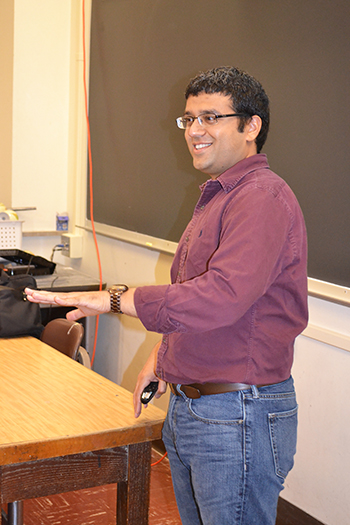
MechSE Assistant Professor Gaurav Bahl teaches Sharlene Denos' senior engineering class about opto-mechanics.
October 15, 2014
While MechSE Assistant Professor Gaurav Bahl is passionate about his research—opto-mechanics —he also believes university folk should get outside the four walls of their labs and impact the community. Plus, he's passionate about mentoring students, especially undergrads. So when he recently shared his expertise with some seniors at Uni High, he invited a couple of his students to tag along to share what they know and to experience outreach for themselves.
To introduce Sharlene Denos' engineering class to his research, Bahl first taught some basic principles about photonic MEMS (micro-electro-mechanical systems) that use optical forces and optical sensing to measure mechanical vibrations. Then Bahl and two students from his research group, undergraduate Shengtai Daniel Shi and Ph.D. student Donggyu Benjamin Sohn, supervised while students used kits to construct devices that use resonance frequency to measure the mass of pennies—even paper clips.
"With this activity they learn the basic principles of optical sensing and mechanical sensing and resonance—typically university level topics—but they get them in a very hands-on way so they can build an intuition about the stuff," says Bahl.
The Uni High students weren't the first high schoolers Bahl has worked with; he and some of his students have done sessions on resonant sensing in the GBAM G.A.M.E.S camps for high school girls in both 2013 and 2014. For this particular activity, Shi spent the entire summer perfecting the activity and developing the kit.
And each time they use the kit for outreach, they improve it. This iteration, to encourage students to think like engineers, they added more flexibility: magnets, moving mirrors, and a variety of cantilevers "so students have complete independence on how they want to move things around," explains Bahl.
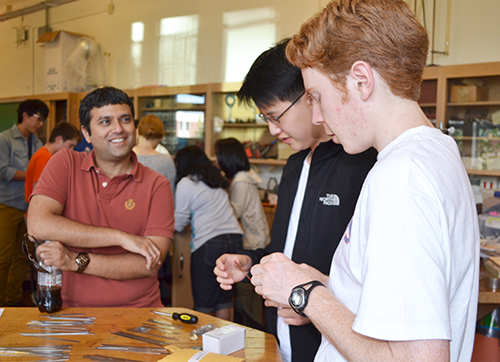
MechSE Assistant Professor Guarav Bahl (left) looks on as two Uni High students choose from an assortment of cantilevers.
How was the activity different from what he would have his college students do? "They might have to derive the equations; they also have the ability to use machine shops and fabricate the materials they need."
But since these were high school students, they gave them ready-made kits and the equations. "We gave them the hard stuff," admits Bahl. Then students were then expected to make engineering decisions based on those equations. "By giving them that flexibility," he adds, "and then defining objectives and constraints for an engineering problem, we make them go through the engineering process."
So the activity was even more challenging—but also more fun—they made it a contest. The teams competed in two areas: to maximize the mass sensitivity of their devices, and to maximize the mass sensitivity, divided by area. "In other words, who can make the most compact, most sensitive device?" Bahl proposes.
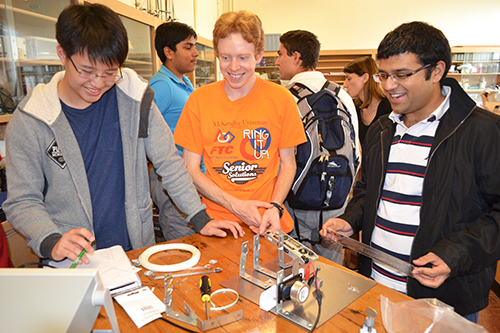
Bahl (right) celebrates with the team members who have just discovered that they won the contest.
Plus, these constraints would expose the students to the kinds of things engineers in the real world face: "That again adds an engineering constraint you would encounter in a typical situation where you have a size limit or you have a power limit, and you have to make the most amazing sensor out of it. So they get exposed to that kind of thinking—the engineering way—at an early stage."
So how did the Uni students do, compared to, say, how his college students would do?
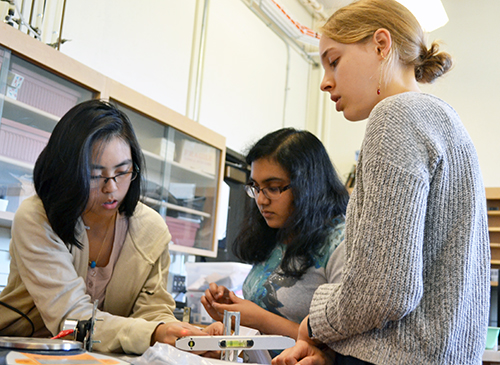
A team of Uni High students work on their project.
Says Bahl: "The students were very interested; they were very exploratory in what they were doing, because we left the constraints open. But they also were able to really use the equations quite a bit. We taught them the basic stuff, and they made the right decisions in that regard, to design their systems better. Given the freedom we gave them and the limited examples that we gave, the students did extremely well."
In fact, Bahl says that though none of the students using their previous kits were able to measure the mass of a single paper clip, these students did (a paper clip weighs .3 grams [300 milligrams]). "It's quite impressive how far they went," says Bahl, noting that while one scale in his lab can weigh things as light as one milligram—its also quite expensive.
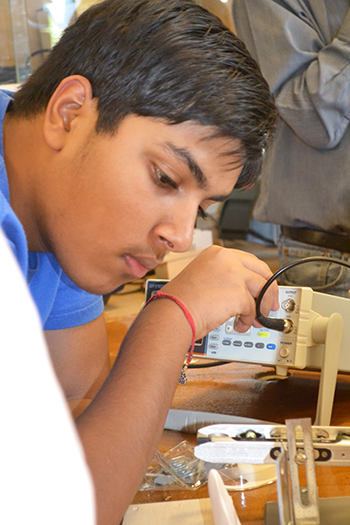
A Uni High student works on his device.
Undergrad Daniel Shi agrees with Bahl's assessment of the students' performance: "I think they performed pretty well, and during the whole experiment they were able to set up the experiments by themselves very quickly. I think after this experiment they have got lots of new knowledge and skills."
So did Bahl see any future engineers? "Plenty. There were a lot of them who were actually really stretching their engineering capability, because it wasn't just blind design; it was intentional design. So most of the students were able to show that kind of capability."
Shi also believes the experience will help the students prepare for college. "I saw many students that have very good potential, especially in science and engineering activities…They have a much stronger interest now. It's very good for them to start getting involved in these education activities to have an understanding of engineering before going to college and universities."
But the high schoolers aren't the only ones to benefit from the outreach; Bahl and his students reap some benefits too. For one, it's a nice break from research.
"It's really fun. You get to really try out some crazy ideas and simple experiments. It takes away some of the edge from just constantly doing research. It's a good distraction."
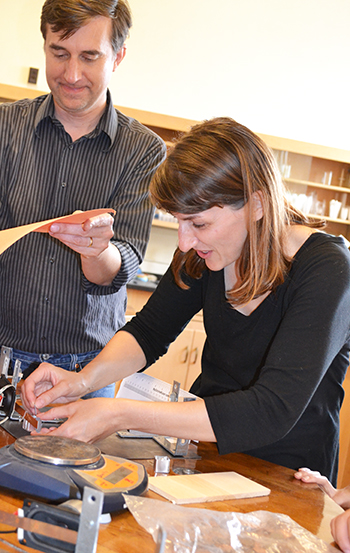
Left to right: MechSE's Joe Muskin prevents a team from seeing the number of paper clips Uni teacher Sharlene Denos is placing into their device's receptacle. The students were to then determine the number of paper clips based on their mass.
Ph.D. student Benjamin Sohn felt he gained some insight into how different students learn engineering. "This is a very good opportunity to learn how students in the United States learn their engineering concepts."
Bahl also appreciated seeing the activity from the students' perspective and getting fresh ideas, such as why the students designed their sensor the way they did. "You learn a lot from these students, because they'll come up with better ideas than you came up with in many cases," he acknowledges. "The way they've been configuring their mirrors and their cantilevers, and the way they're approaching the problem, is not necessarily the way I would have done it. Basically every time we do this kind of activity, we learn from it."
Plus, Bahl admits that he personally never has enough time to use a kit and come up with all the possibilities, so each time they do the activity, he garners input from the students.
So during the contest on the last day of the outreach, he asked the students some probing questions, partly to see if they understood what they had done, but also to pick their brains "to see if they had a better mounting strategy than I did," he admits.
Bahl has an even broader vision for the kits than using them with the small numbers of students he and his students can personally impact. Once they finish developing the kits to their fullest potential as learning tools, he hopes to make the activity and parts list available to other educators. For example, he says the kits are very cheap (less than $30) to make, and most of the materials can be purchased at any local hardware store.
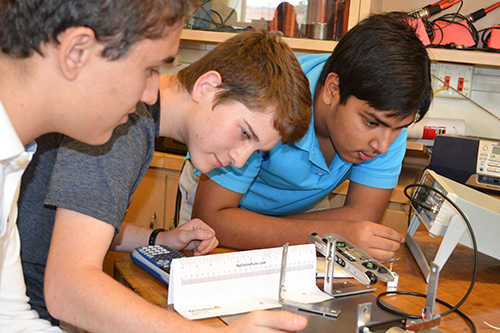
A team of students runs one last test on their device.
While Bahl is passtionate about outreach to P–12 students, he's also passionate about undergrad students getting involved in research early in their college careers.
"A lot of them wait until their senior year to think about research, and that's not necessarily the right decision, because they don't get enough time to complete a study."
Bahl likes to recruit undergrads once they hit their junior year, indicating that "They have enough knowledge and ability to then really take up a topic of research, and enough time to explore it."
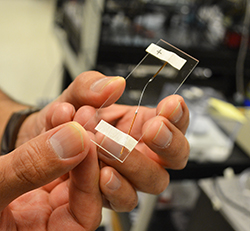
Bahl displays one of the devices his team designed.
One unique characteristic of Bahl's undergrads is that they all have published papers while still undergraduates. And while students publishing papers as undergrads is not completely unheard of, Bahl says, "It is definitely rare; it's even more rare for an undergraduate student to have a first author paper out of their undergraduate work in a proper, well-renowned, peer-reviewed journal; that is extremely rare." But one of his students has; recent MechSE graduate Kaiyuan Zhu, has published two, one as first author. Another of his undergrads Nathan Dostart, who graduated in May, is also working on a paper about his undergraduate work. Bahl finds their early success extremely gratifying.
"It is very rewarding. So my undergraduate students have published roughly as many papers as my graduate students, so far."

Illinois undergrad Daniel Shi (left) watches as a student works on his device.
What's more, even though a number of his undergrad students have graduated and moved on, Bahl continues to mentor them, "I have to, because if they've done a study, we need to publish it. We're not going to leave that aside and forget about it."
Given a chance to express any final thoughts, Bahl once again urges undergraduate students to take advantage of both research and outreach:
"I think I would encourage undergraduate students that it's never too early to get started in research and in educational outreach. It's very important for us as scientists to engage with our communities, because we don't really do that very often…I think we should think beyond what we do at the university."
Story and photos by Elizabeth Innes, Communications Specialist, I-STEM Education Initiative.
More: Faculty Feature, G-BAM, MechSE, 2014
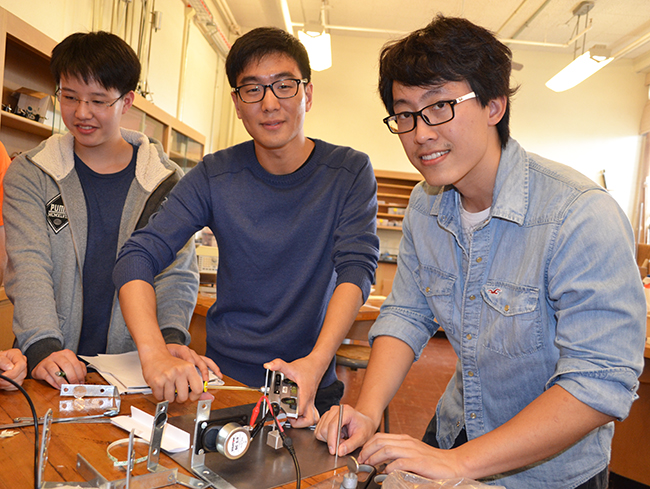
Donggyu Benjamn Sohn (center) and Shengtai Daniel Shi (right), members of Dr. Bahl's research group, work with some of Denos' engineering students.













.jpg)
















